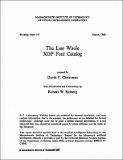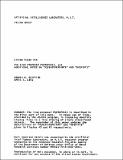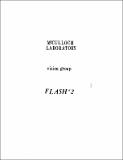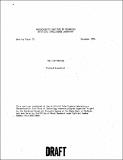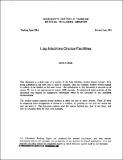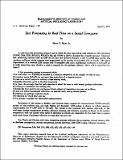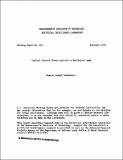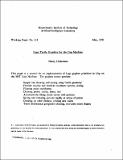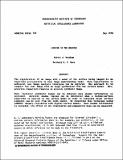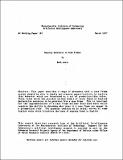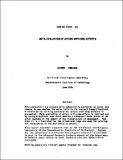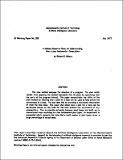Browsing AI Working Papers (1971 - 1995) by Title
Now showing items 135-154 of 291
-
The L%LINES Package
(MIT Artificial Intelligence Laboratory, 1971)The program (L%LINES X Y) takes feature point output from the FP%FPOINTS program (q.v.) for horizontal and vertical scans (X and Y respectively); and outputs a list consisting of two lists of line segments, represented in ... -
The Last Whole XGP Font Catalog
(MIT Artificial Intelligence Laboratory, 1980-03) -
Laws for Communicating Parallel Processes
(MIT Artificial Intelligence Laboratory, 1976-11)This paper presents some "laws" that must be satisfied by computations involving communicating parallel processes. The laws take the form of stating restrictions on the histories of computations that are physically realizable. ... -
Laws for Communicating Parallel Processes
(MIT Artificial Intelligence Laboratory, 1977-05-10)This paper presents some laws that must be satisfied by computations involving communicating parallel processes. The laws are stated in the context of the actor theory, a model for distributed parallel computation, and ... -
The Line Proposer P%PROPOSE1, and Additional Notes on "F%FEATUREPOINTS" and "GVERIFY1"
(MIT Artificial Intelligence Laboratory, 1971-04-02)The line proposer P%PROPOSE1 is described in the first part of this memo. It makes use of links provided by the J%JOIN program, in proposing possibly missing lines in a line drawing of simple plane-faced objects. The ... -
The Line Verifier GVERIFY1
(MIT Artificial Intelligence Laboratory, 1971)A line verifier is presented which, given the co-ordinates of the end points of the hypothesized line, returns a (possibly) more accurate version of the end points, together with an estimate of the probability that there ... -
The LISP Machine
(MIT Artificial Intelligence Laboratory, 1974-11) -
Lisp Machine Choice Facilities
(MIT Artificial Intelligence Laboratory, 1981-06)This document is a draft copy of a portion of the Lisp Machine window system manual. It is being published in this form now to make it available, since the complete window system manual is unlikely to be finished in the ... -
List Processing in Real Time on a Serial Computer
(MIT Artificial Intelligence Laboratory, 1977-04-01)A real-time list processing system is one in which the time required by each elementary list operation (CONS, CAR, CDR, RPLACA, RPLACD, EQ, and ATOM in LISP) is bounded by a (small) constant. Classical list processing ... -
Logical Control Theory Applied to Mechanical Arms
(MIT Artificial Intelligence Laboratory, 1979-02)A new control algorithm based upon Logical Control Theory is developed for mechanical manipulators. The controller uses discrete tesselations of state space and a finite set of fixed torques to regulate non-rehearsed ... -
Logo Turtle Graphics for the Lisp Machine
(MIT Artificial Intelligence Laboratory, 1981-05-05)This paper is a manual for an implementation of Logo graphics primitives in Lisp on the MIT Lisp Machine. The graphics system provides: Simple line drawing and erasing using "turtle geometry" Flexible relative and absolute ... -
Looking in the Shadows
(MIT Artificial Intelligence Laboratory, 1976-05)The registration of an image with a model of the surface being imaged is an important prerequisite to many image understanding tasks. Once registration is achieved, new image analysis techniques can be explored. One approach ... -
MAPPER Information
(MIT Artificial Intelligence Laboratory, 1974-09)This working paper describes a program on the Mini-Robot PDP-11 which is used for looking at picture files created by the VIDIN program. It may be used by ITS vision programmers to examine Vidicon picture files before ... -
Mapping Sentences to Case Frames
(MIT Artificial Intelligence Laboratory, 1977-03)This paper describes a range of phenomena that a case frame system should be able to handle and proposes generalizations to capture this behavior which are formulated as a set of production-like rules. These rules allow ... -
Mechanical Arm Control
(MIT Artificial Intelligence Laboratory, 1973-03-19)This paper discusses three main problems associated with the control of the motion of a mechanical arm. 1) Transformation between different coordinate systems used to describe the state of the arm. 2) Calculation of ... -
Merging Illustrations and Printing on Big Paper
(MIT Artificial Intelligence Laboratory, 1987-07)How to guide for some of the printing utilities in the AI lab. Describes how TEX tiles are processed and how some illustrations may be merged into the final copy. Also describes how to use TEX to print on 8.5x14 (legal) ... -
Meta-evaluation of Actors with Side-effects
(MIT Artificial Intelligence Laboratory, 1975-06)Meta-evaluation is a process which symbolically evaluates an actor and checks to see whether the actor fulfills its contract (specification). A formalism for writing contracts for actors with side-effects which allow sharing ... -
Meta-evaluation of Actors with Side-effects
(MIT Artificial Intelligence Laboratory, 1975-06)Meta-evaluation is a process which symbolically evaluates an actor and checks to see whether the actor fulfills its contract (specification). A formalism for writing contracts for actors with side-effects is presented. ... -
A Method, Based on Plans, for Understanding How a Loop Implements a Computation
(MIT Artificial Intelligence Laboratory, 1977-07)The plan method analyzes the structure of a program. The plan which results from applying the method represents this structure by specifying how the parts of the program interact. This paper demonstrates the utility of the ... -
Mini-Robot Group User's Guide
(MIT Artificial Intelligence Laboratory, 1974-03)This working paper describes the facilities of the mini-robot group and the software available to persons using those facilities.

